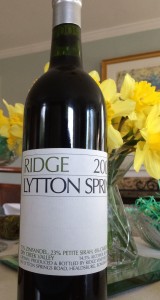There’ a nip in the air, multi-colored leaves are falling from the trees and football season is in full swing! It’s officially autumn, and I’m ready for a hearty dinner with full-bodied wine to celebrate my favorite time of the year. And also, with Columbus Day here, I’m going to recommend two Italian wines to accompany the tasty recipe for bacon-wrapped pork tenderloin I’ve provided for you below.
I know the Columbus Day holiday has been widely critiqued for the cavalier manner and heavy-handed actions of the explorer for whom the holiday is named. Christopher Columbus does deserve criticism because he was, at best, directionally challenged. Here’s a guy who traveled west to find a quicker route to the east and ended up discovering North…. America. But Columbus did introduce our continent to Italian wine, and I’m grateful to him, at least, for that.
Most of you probably know about Italy’s Tuscan wine appellation. The region is noted for producing Chianti and Brunello di Montalcino, both of which are made from the ubiquitous local grape, sangiovese. However, the Tuscan wines I’m suggesting to accompany the recipe below lean heavily on a blend of Bordeaux-style grapes.
The primary grapes used in this blend are cabernet sauvignon, merlot, cabernet franc and even syrah – or some combination of them all. Some of the blends include small amounts of sangiovese, but the resulting wine is fuller-bodied and more age-worthy than most other Tuscan red wines. Legendary wine critic, Robert Parker, called the wine a “Super Tuscan,” and the term stuck.
Acceptance by the Italian government of the non-traditional blend that comprises a Super Tuscan came only after years of wrangling. The government did not prohibit wineries from using different grapes (like cabernet or merlot) than those approved for a specific Italian region, but the resulting wine had to be labeled as “vino de tavola” or table wine. That designation was viewed by the Super Tuscan winemakers as indicating that the wine in the bottle was simple and ordinary, and they insisted on a new label classification.
With extreme pressure from many influential Italian winemakers, the government finally established a new classification – IGT (indicazione geografica tipica) allowing wineries to produce wine from grapes not approved by them- as long as the label featured the “IGT” logo. The rest, as they say, is history and Super Tuscans are now considered to be among the most coveted of all Italian wines. Some Super Tuscans are also among the most expensive wines anywhere, but the two wines I’m recommending are delicious examples of providing exceptional quality for a reasonable price.
You might want to try one of the two Super Tuscans below with the bacon wrapped pork tenderloin recipe. I accompanied the dish with a medley of grilled onions, asparagus and yellow squash.
2021 Ornellaia Le Volte ($30)– The wine is comprised of Made merlot with smaller proportions of cabernet sauvignon and sangiovese. It has bright fruit flavors of ripe, red cherries with notes of cola and tea. The balanced acidity makes it a perfect accompaniment to the bacon wrapped pork tenderloin.
2019 Guado al Tasso “Il Bruciato” ($35) Antinori is one of the Super Tuscan pioneering wine families and Il Bruciato is a rich, jammy blend of cabernet sauvignon, merlot and syrah. With flavors of blackberries and chocolate and a touch of vanilla, this full-bodied wine should pair well with smoky, rich, meaty flavors of today’s recipe feature.
Bacon Wrapped Pork Tenderloin
Ingredients
One pound pork tenderloin
Six (or more) slices of thinly cut bacon
One-fourth cup of shredded mozzarella
One tablespoon each of chopped parsley and rosemary
One-quarter cup each of diced onions and red bell peppers
Three tablespoons of extra virgin olive oil, Balsamic vinegar and minced garlic
One teaspoon each smoked paprika, kosher salt and coarsely ground black pepper
Ten (or more) wooden toothpicks
Preparation
Cut pork tenderloin lengthwise to create a deep pocket
Rub interior and exterior with salt, pepper and paprika
Mix balsamic, olive oil (half )and garlic and rosemary in a bowl for marinade
Place pork tenderloin in container or plastic bag and marinate for at least four hours
Use remaining oil to saute onions, parsley and red pepper and allow to cool
Remove tenderloin from marinade and place on a work surface
Mix sauteed veggies and cheese together and place in tenderloin
Wrap tenderloin completely with bacon strips
Use toothpicks to keep bacon wrapped tenderloin from falling apart
Place tenderloin on oven rack and set temperature t at 400F
Bake for 20 minutes or until internal temperature of pork is 145F
Remove the toothpicks, slice into quarter inch rounds and serve
John Brown is also a novelist. His latest book, Augie’s World, is a sequel to his debut novel, Augie’s War. Both novels are available in print and audio at Amazon. You can find out more about his novels and wine columns at wordsbyjohnbrown.com





